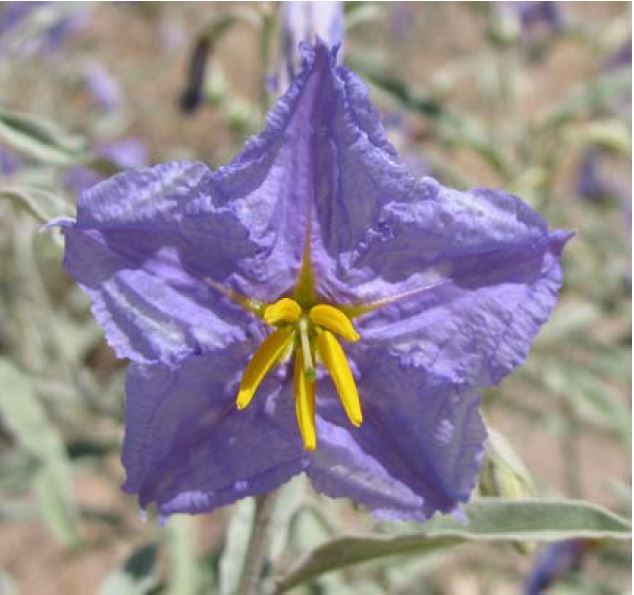Southwest Yard & Garden – Controlling Perennial Weeds: Silverleaf Nightshade and Nutsedges

Silverleaf nightshade flowers are beautiful, but parts of the plant are toxic to humans and animals. Photo from NMSU Extension Guide “Silverleaf Nightshade” W-15.
Question: Silverleaf nightshade and nutsedge are taking over parts of my yard! Please help. Organic control options are appreciated.
Helen B., Las Cruces, NM
Answer: A few years ago, I asked NMSU Extension Weed Specialist, Dr. Leslie Beck, to explain why annual weeds like sandburs and goatheads are so difficult to control and to give us options for managing them without the use of pesticides. Visit Desert Blooms: The Early Bird Catches the Weed to read that column.
The two weeds for this week, silverleaf nightshade (Solanum elaeagnifolium) and nutsedge (Cyperus esculentus and Cyperus rotundus, aka yellow and purple nutsedge, respectively), are perennial plants, and control tactics are different than for annual weeds. Both of these perennials have modified stems that lurk below the soil surface and make control especially tricky. And both have NMSU Cooperative Extension publications dedicated to their identification and control:
- Silverleaf Nightshade: NMSU O&T Guide W-15: Silverleaf Nightshade
- Yellow and Purple Nutsedges: NMSU O&T Guide W-12: Yellow and Purple Nutsedge
Dr. Beck explains how these perennial weeds persist and the best ways to gain the upper hand:
“Nightshade and nutsedge are hearty, perennial weeds that grow back from underground tissues every year. Nutsedge has very aggressive tubers (i.e., nutlets) and nightshade has aggressive rhizomes. Both tubers and rhizomes grow underground laterally from the central stem of a plant and have the ability to develop entirely new and self-sustainable plant clones. The entirety of both the aboveground and underground systems must be addressed for successful control, thus leading to their status as difficult-to-control weeds.
“Your primary method of organic control for complex perennial weeds is physical removal. Using a garden trowel, shovel, or a long digging knife will allow you to dig up as much of the root systems as possible (including tubers and rhizomes). Getting those belowground modified stems out is the key. No matter how careful you are, chances are there will be some tissue left in the soil. The more you remove, the more energy the plants have to use to recover and the longer it will take for the plant to begin growing back. Just like the control of annuals, persistence and scouting are crucial to long-term success. Once the new growth starts breaking the soil surface in an attempt to recover and photosynthesize, you dig them up again, and again, and again. The longer the plant sees sunlight, the more photosynthesis feeds the modified stems and root system, the more it recovers, and the more difficult control efforts will be for a longer period of time.
“Because of these robust underground systems, organic herbicides, generally consisting of combinations of acids and oils, will not be effective on perennial plants with modified stems and an aggressive root system. The primary reason for this is that acids and oils are contact herbicides, meaning they will only affect the plant tissue that they come into contact with. Thus, even if the aboveground plant tissue is damaged, it will simply grow back from the rhizomes and tubers. It is also not recommended to use salts (e.g., Epsom salts, table salts, water-softening salts) or salt-based mixtures as herbicides since it will cause further damage and future problems in soils that are already highly salty. There are some non-organic herbicide options available for these plants, but I would need to know more about the system in which you working (e.g., a flowerbed, driveway, orchard, or vegetable bed) to make appropriate recommendations. Be sure to always follow chemical label instructions. Please contact your local County Extension Agent or the NMSU Extension Weed Specialist for information on these products.
“As for environmental conditions that these weeds hate, your best bet may be growing healthy, dense, and competitive desirable plants in the landscape to outcompete the weedy ones for water, nutrients, space, and sunlight. For example, if these weeds are in a lawn area, the healthier your grass is, the more it will be able to outcompete the weeds.

Yellow nutsedge seedhead (photo credit L. Beck).
“Here’s another tip: The presence of some weeds might be an indication of problems within management that need to be addressed. For example, nutsedges love saturated soils. If you have high populations of them in certain areas, try improving drainage or decreasing the watering amount and frequency, so the soil dries out more between irrigation events. These conditions may be more ideal for your desirable plants which gives them an even greater competitive edge over the weeds.”
For tips on how to identify purple vs. yellow nutsedge and more info on controlling them both, click here for our September 2018 column “Livin’ on the Sedge.” Weed samples can also be submitted via your County Extension Agent to the NMSU Plant Diagnostic Clinic for identification.
Join us for the next Ready, Set, GROW! Gardening Webinar at 3 pm on Wednesday, February 17th for Dr. Beck’s presentation “Winter Weed Management.” Register at Ready Set GROW!. If you can’t log in for the live session, that’s okay; each webinar is recorded, and a video link will be posted on the registration page.
Guest author Dr. Leslie Beck (NMSU Extension Weed Specialist) is based in Las Cruces. Regular author Dr. Marisa Thompson (NMSU Extension Urban Horticulture Specialist) is based at the NMSU Agricultural Science Center at Los Lunas. Follow Dr. Beck on Twitter: @NmsuWeeds
For more gardening information, visit the NMSU Extension Horticulture page at Desert Blooms (http://desertblooms.nmsu.edu/) and the NMSU Horticulture Publications page at http://aces.nmsu.edu/pubs/_h/.
